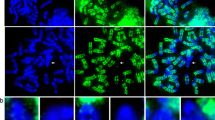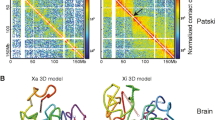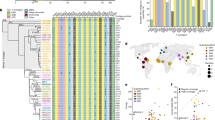Abstract
We report the partial characterization of a novel putative zinc finger gene of the Krüppel-type (ZNF81), isolated from an X Chromosome (Chr) specific library. The pattern of segregation in human-hamster somatic cell hybrids of sequences homologous to the ZNF81 finger domain has established that it resides within the Xp22.1-Xp11 region. ZNF81 represents yet another example, together with ZFX, ZNF41, and ZNF21, of members of the zinc finger gene family residing within the short arm of the human X Chr. Sequence analysis showed that ZNF81 may encode a polypeptide(s) containing tandem arrays of 12 canonical C2H2 zinc fingers of the Krüppel-type at the C-terminus. Northern analysis indicated that probes from the ZNF81 finger domain hybridize to polyadenylated transcripts present in several cell lines, a result that supports the hypothesis that it is an expressed, functional member of this multigene family.
Similar content being viewed by others
References
Aubry, M., Marineau, C., Rong Zhang, F., Zahed, L., Figlewicz, D., Delattre, O., Thomas, G., De Jong, P.J., Julien, J.P., and Rouleau, G.A. (1992). Cloning of six new genes with zinc finger motifs mapping to short and long arms of human acrocentric chromosome 22 (p and q11.2). Genomics 13, 641–648.
Bellefroid, E.J., Lecocq, P.J., Benhida, A., Poncelet, D.A., Belayew, A., and Martial, J.A. (1989). The human genome contains hundreds of genes coding for finger proteins of the Krüppel type. DNA 8, 377–387.
Berg, J. (1990) Zinc figers and other metal-binding domains. J. Biol. Chem. 265, 6513–6516.
Brown, R.S., Sander, C., and Argos, P. (1985). The primary structure of transcription factor TFIIIA has 12 consecutive repeats. FEBS Lett. 186, 271–274.
Call, K.M., Glaser, T., Caryn, Y.I., Buckler, A.J., Pellettier, J., Haber, D.A., Rose, E.A., Kral, A., Yeger, H., Lewis, W.H., Jones, C., and Housman, D.E. (1990). Isolation and characterization of a zinc finger polypeptide gene at the human chromosome 11 Wilm's tumor locus. Cell 60,509–520.
Chavrier, P., Zerial, M., Lemaire, P., Almendral, J., Bravo, R., and Charnay, P. (1988a). A gene encoding a protein with zinc fingers is activated during G0/G1 transition in cultured cells. EMBO J. 7, 29–35.
Chavrier, P., Lemaire, P., Relevant, O., Bravo, R, and Charnay, P. (1988b). Characterization of a mouse multigene family that encodes zinc finger structures. Mol. Cell. Biol. 8, 1319–1326.
Chowdhury, K., Deutsch, U., and Gruss, P. (1987). A multigene family encoding several “finger” structures is present and differentially active in mammalian genomes. Cell 48, 771–778.
Christy, B.A., Lau, L.F., and Nathans, D. (1988). A gene activated in mouse 3T3 cells by serum growth factors encodes a protein with “zinc finger” sequences. Proc. Natl. Acad. Sci. USA 85, 7857–7860.
Donti, E., Lanfrancone, L., Huebner, K., Pascucci, A., Venti, G., Pengue, G., Grignani, F., Croce, C., Lania, L., and Pelicci, P-G. (1990). Localization of the human HF.10 finger gene on a chromosome region frequently deleted in human cancers. Hum. Genet. 84, 391–395.
Franzé, A., Archidiacono, N., Rocchi, M., Marino, M., and Grimaldi, G. (1991). Isolation and expression analysis of a human zinc finger gene (ZNF41) located on the short arm of the X chromosome. Genomics 9, 728–736.
Hartshorne, T.A., Blumberg, H., and Young, E.T. (1986). Sequence homology of the yeast regulatory protein ADR1 with Xenopus transcription factor IIIA. Nature 320, 283–287.
Hoovers, J.M.N., Mannens, M., John, R., Bliek, J., Van Heyningen, V., Porteous, D.J., Leschot, N.J., Westerveld, A., and Little, P.F.R. (1992). High-resolution localization of 69 potential human zinc finger protein genes: a number are clustered. Genomics 12, 254–263.
Huebner, K., Druck, T., Croce, C., and Thiesen, H.J. (1991). Twenty-seven nonoverlapping zinc finger cDNAs from human T cells map to nine different chromosomes with apparent clustering. Am. J. Hum. Genet. 48, 726–740.
Kadonaga, J.T., Carner, K.R., Masiarz, F.R., and Tijan, R. (1987). Isolation of cDNA encoding transcription factor SP1 and functional analysis. Cell 51, 1079–1090.
Kinzler, K.W., Ruppert, J.M., Bigner, S.H. and Vogelstein, B. (1988). The Gli gene is a member of the Krüppel family of zinc finger proteins. Nature 332, 371–374.
Klevit, R.E. (1991). Recognition of DNA by Cys2, Cys2, His2 zinc fingers. Science 253, 1367.
Koster, M., Pieler, T., Poting, A., and Knochel, W. (1988). The finger motif defines a multigene family represented in the maternal mRNA of Xenopus laevis oocytes. EMBO J. 7, 1735–1741.
Lania, L., Donti, E., Pannuti, A., Pascucci, A., Pengue, G., Feliciello, I., La Mantia, G., Lanfrancone, L., and Pelicci, P-G. (1990). cDNA isolation, expression analysis, and chromosomal localization of two human zinc finger genes. Genomics 6, 333–340.
Lloyd, S.L., Sargent, C.A., Chalmers, J., Lim, E., Habeebu, S.S.M., and Affara, N.A. (1991). An X-linked zinc finger gene mapping to Xq21.1-q21.3 closely related to ZFX and ZFY: posible origins from a common ancestral gene. Nucleic Acids Res. 19, 4835–4841.
Mandel, J.L., Willard, H.F., Nussbaum, R.L., Romeo, G., Puck, J.M., and Davies, K.E. (1989). Human gene mapping 10: report of the committee on the genetic constitution of the X chromosome. Cytogenet. Cell Genet. 51, 384–437.
Maniatis, T., Fritsch, E.F., and Sambrook, J. (1982). Molecular Cloning: A Laboratory Manual. Cold Spring Harbor, N.Y.: Cold Spring Harbor Laboratory Press.
Miller, J., McLahan, A.D., and Klug, A. (1985). Repetitive zincbinding domains in the protein transcription factor-IIIA from Xenopus occytes. EMBO J. 4, 1609–1614.
Morshita, K., Parker, D.S., Mucenski, M.L., Jenkins, N.A., Copeland, N.G., and Ihle, J.N. (1988). Retroviral activation of a novel gene encoding a zinc finger protein in IL-3-dependent myeloid leukemia cell lines. Cell 54, 831–840.
Nagai, K., Nakaseko, Y., Nasmyth, K., and Rhodes, D. (1988). Zinc finger motifs expressed in E. coli and folded in vitro direct specific binding to DNA. Nature, 332, 284–286.
Ohlendorf, D.H. and Matthews, B. (1983). Structural studies of protein-nucleic acid interaction. Annu. Rev. Biophys. Bioeng. 12, 259–284.
Page, D.C., Mosher, R., Simpson, E.M., Fisher, E.M.C., Mardon, G., Pollack J., McGillivray, B., De La Chapelle, A., and Brown, L.G. (1987). The sex determining region of the human Y chromosome encodes a finger protein. Cell 51, 1091–1104.
Page, D.C., Disteche, C.M., Simpson, E.M., De La Chapelle, A., Andersson, M., Alitalo, T., Brown, L.G., Green, P., and Akots, G. (1990). Chromosomal localization of ZFX—a human gene that escapes X inactivation—and its murine homologs. Genomics 7, 36–46.
Pannuti, A., Lanfrancone, L., Pascucci, A., La Mantia, G., Pelicci, P.-G., and Lania, L. (1988). Isolation of cDNA clones encoding finger proteins and measurement of the corresponding mRNA levels during myeloid terminal differentiation. Nucleic Acids Res. 16, 4227–4237.
Passananti, C., Felsani, A., Caruso, M., and Amati, P. (1989). Mouse genes coding for “zinc-finger”-containing proteins: characterization and expression in differentiated cells. Proc. Natl. Acad. Sci. USA 86, 9417–9421.
Patwardhan, S., Gashler, A., Siegel, M.G., Chang, L.C., Joseph, L.J., Shows, T.B., Le Beau, M.M., and Sukhatme, V.P. (1991). EGR3, a novel member of the EGR family of genes encoding immediate-early transcription factors. Oncogene 6, 917–928.
Pavletich, N.P. and Pabo, C.O. (1991). Zinc finger-DNA recognition: crystal structure of a Zif268-DNA complex at 2.1 A. Science 252, 809–817.
Rocchi, M., Roncuzzi, L., Santamaria, R., Archidiacono, N., Dente, L., and Romeo, G. (1986). Mapping through somatic cell hybrids and cDNA probes of protein C to chromosome 2, factor X to chromosome 13, and alpha 1-acid-glycoprotein to chromosome 9. Hum. Genet. 74, 30–33.
Romano, V., Bosco, P., Rocchi, M., Costa, G., Leube, R.E., Franke, W.W., and Romeo, G. (1988). Chromosomal assignments of human type I and type II cytokeratin genes to different chromosomes. Cytogenet. Cell Genet. 48, 148–151.
Rosati, M., Marino, M., Franzé, A., Tramontano, A., and Grimaldi, G. (1991). Members of the zinc finger protein gene family sharing a conserved N-terminal module. Nucleic Acids Res. 19, 5661–5667.
Rosenberg, U.B., Schroder, C., Preiss, A., Kienlin, A., Cote, S., Riede, I., and Jäckle, H. (1986). Structural homology of the product of the Drosophila Krüppel gene with Xenopus transcription factor IIIA. Nature 319, 336–339.
Rousseau-Merck, M.F., Huebner, K., Berger, R., and Thiesen, H.J. (1991). Chromosome assignment of two human zinc finger genes, Kox17 (ZNF24) and Kox26 (ZNF 29), to 18q12 and 17p12p13 respectively. Genomics 9, 154–161.
Ruiz i Altaba, A., Perry-O'Keefe, H., and Melton, D.A. (1987). An embryonic gene encoding a multifingered protein in Xenopus. EMBO J. 6, 3065–3070.
Ruppert, J.M., Kinzler, K.W., Wong, A.J., Bigner, S.H., Kao, F.T., Law, M.L., Seunaez, H.N., O'Brien, S.J., and Vogelstein, B. (1988). The GLI-Krüppel family of human genes. Mol. Cell. Biol. 8, 3104–3113.
Schuh, R., Aicher, W., Gaul, U., Cote, S., Preiss, A., Maier, D., Seifert, E., Nauber, U., Schroder, C., Kemler, R., and Jäckle, H. (1986). A conserved family of nuclear proteins containing structural elements of the finger protein encoded by Krüppel, a Drosophila segmentation gene. Cell 47, 1025–1032.
Sukhatme, V.P., Cao, X., Chang, L.C., Tsai-Morris, C.H., Stamenkovic, D., Ferreira, P., Cohen, D.R., Edwards, S.A., Shows, T.B., Curran, T., LeBeau, M.M., and Adamson, E.D. (1988). A zinc finger-encoding gene coregulated with c-fos during growth and differentiation and after cellular depolarization. Cell 53, 37–43.
Suthers, G.K., Hyland, V.J., Callen, D.F., Oberle, I., Rocchi, M., Thomas, N.S., Morris, C.P., Schwartz, C.E., Schmidt, M., Ropers, H.H., Baker, E., Oostra, B.A., Dahl, N., Wilson, P.J., Hopwood, J.J., and Sutherland, G.R. (1990). Physical mapping of new DNA probes near the fragile X (FRAXA) with a panel of cell lines. Am. J. Hum. Genet. 47, 187–195.
Tautz, D., Lehman, R., Schnurch, H., Schuh, R., Seifert, E., Kienlin, A., Jones, K., and Jäckle, H. (1987). Finger protein of novel structure encoded by hunchback, a second member of the gap class of Drosophila segmentation genes. Nature 327, 383–389.
Thiesen, H.J. (1990). Multiple genes encoding zinc finger domains are expressed in human T cells. New Biol. 2, 363–374.
Villa, A., Patrosso, C., Biunno, I., Frattini, A., Repetto, M., Mostardini, M. Evans, G., Susani, L., Strina, D., Redolfi, E., Lazzari, B., Pellegrini, M., and Vezzoni, P. (1992). Isolation of a zinc finger motif (ZNF75) mapping on chromosome Xq26. Genomics 13, 1231–1236.
Vortkamp, A., Gessler, M., and Grzeschik, K.H. (1991). GLI3 zincfinger gene interrupted by translocations in Greig syndrome families. Nature 352, 539–540.
Vrana, K.E., Churchill, M.E., Tullius, T.D., and Brown, D.D. (1988). Mapping functional regions of transcription factor TFIIIA. Mol. Cell. Biol. 8, 1684–1696.
Author information
Authors and Affiliations
Rights and permissions
About this article
Cite this article
Marino, M., Archidiacono, N., Franzé, A. et al. A novel X-linked member of the human zinc finger protein gene family: isolation, mapping, and expression. Mammalian Genome 4, 252–257 (1993). https://doi.org/10.1007/BF00417431
Received:
Accepted:
Issue Date:
DOI: https://doi.org/10.1007/BF00417431




